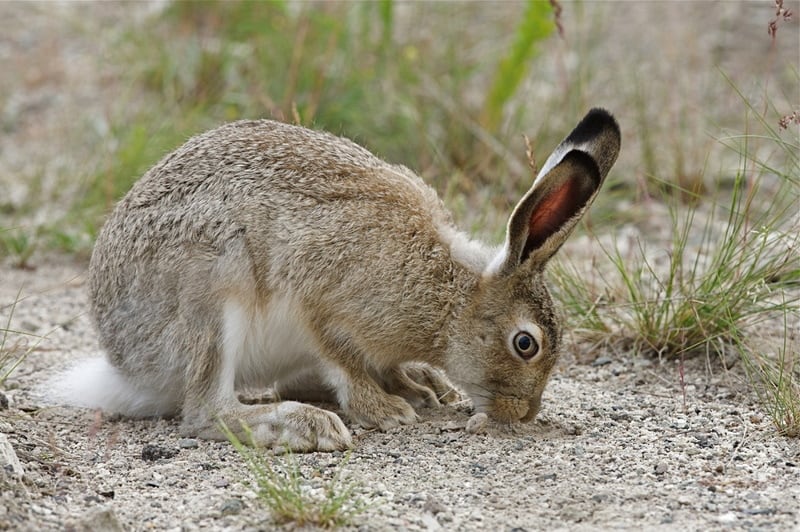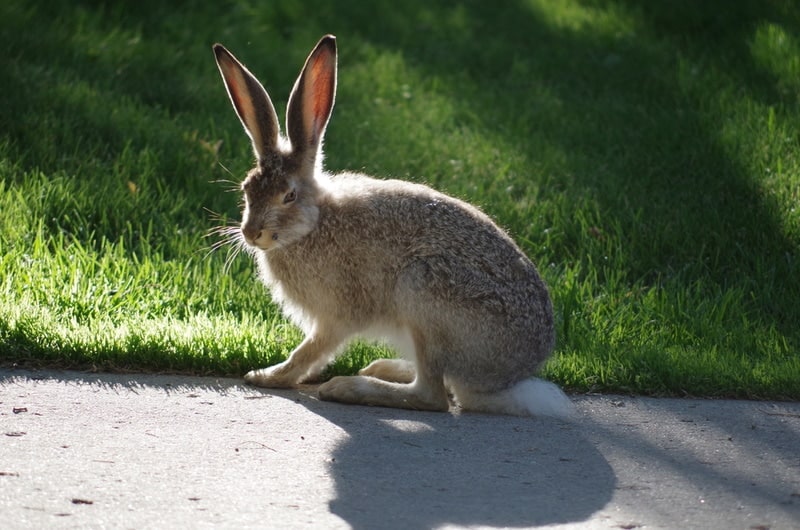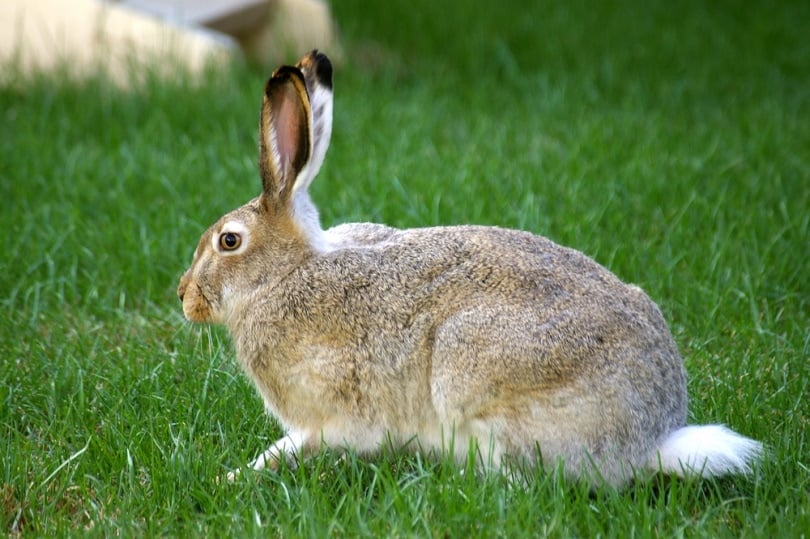Temperament & Intelligence
Food & Diet
Natural Habitat
Population Threats
Mating Habits
Fun Facts
[/jump-links]
The White-Tailed Jackrabbit, also known as the Prairie Hare and White Jack, is not a rabbit at all but a hare. It’s one of the largest hare species and the largest of the hares known commonly as “jackrabbits”. Found in western North America, White-Tailed Jackrabbits are nocturnal, solitary hares that reside in hilly bunchgrass sites.
Though they’re common across their natural range, the White-Tailed Jackrabbit population is in a slight decline from habitat loss or retaliatory killing. In some cases, young Jackrabbits may be adopted by well-meaning people who mistakenly believe they’ve been abandoned by their mothers. Despite their similarities to rabbits, Jackrabbits are not domesticated and do not make good pets.
| Size: | Large |
| Weight: | Up to 8 lbs |
| Lifespan: | 3–8 years |
| Similar Breeds: | Black-Tailed Jackrabbit, European Hare, Snowshoe Hare |
| Suitable for: | The wild |
| Temperament: | Solitary, aloof |
White-Tailed Jackrabbits have a lot in common with other large hares, including the Arctic and Alaskan Hares. It’s one of the largest hares in North America and has a long body and abnormally large ears. Adept at camouflage, the White-Tailed Jackrabbit is a dark brown or grayish brown with pale gray coloring, a dark central stripe, and dark ear tips that hide it in the natural environment. In winter, the White-Tailed Jackrabbit becomes completely white to blend in with the snow.
White-Tailed Jack Rabbit Characteristics
[yasr_multiset setid=7]

Temperament & Intelligence of the White-Tailed Jackrabbit
White-Tailed Jackrabbits are an understudied wild hare species, so not much is known about their intelligence. They’re likely on par with other hare species and have the ability to adapt to changes in their environment. But unlike rabbits and hares, they don’t spend time with other jackrabbits and lack the social development that comes with being in a colony.
These hares are not appropriate to keep as pets or interact with in the wild. They hide well and will try to flee if they sense threats, but cornered, they will fight back with strong kicks or bites. With many natural predators, White-Tailed Jackrabbits tend to be extremely flighty and quick to react to any sound or disturbance.

Do These Rabbits Make Good Pets?
No, White-Tailed Jackrabbits are not good pets. Aside from being a wild animal that’s illegal to keep as a pet in many locations, White-Tailed Jackrabbits are nocturnal and extremely solitary. Unlike domesticated rabbit species, they don’t exist in colonies in the wild. In fact, Jackrabbits only come together during the mating season. They’re also aggressive, skittish, and can be prone to stress-related illnesses.
Does This Rabbit Get Along With Other Animals?
No, the White-Tailed Jackrabbit doesn’t enjoy the presence of other animals, including other Jackrabbits. The female hare will only spend time with other hares during courting rituals in the mating season. White-Tailed Jackrabbits are an important prey species for mammalian predators like American badgers, coyotes, bobcats, and red and gray foxes as well, so they’re naturally wary of other animals.

Things to Know About White-Tailed Jackrabbits:
Food & Diet
Like rabbits, White-Tailed Jackrabbits are herbivores and feed on grasses and green plants, including cultivated crops. In winter, they subsist on buds, twigs, and the bark of low shrubs. Because they’re more selective than the other large North American hare, the Black-Tailed Jackrabbit, they’re at a disadvantage where these two species’ range overlaps.
Habitat
The White-Tailed Jackrabbit is native to western and central parts of North America. The natural range spans from British Columbia, Alberta, Saskatchewan, Manitoba, and Ontario in Canada to Washington, Oregon, California, Nevada, Utah, Idaho, Montana, Wyoming, Colorado, New Mexico, the Dakotas, Nebraska, Kansas, Minnesota, Wisconsin, Iowa, Missouri, and Illinois in the US. They live in plains, prairies, and alpine meadows with coniferous trees.

Population Threats
White-Tailed Jackrabbits play an important role in the ecosystem. They influence the composition of the land with selective grazing and are one of the vital prey species for an array of predators, including foxes, coyotes, bobcats, and the American badger. Raptors like golden eagles, bald eagles, owls, and hawks also prey on Jackrabbits, as well as some snakes, mountain lions, and wolves.
Despite their numbers and vast range, the White-Tailed Jackrabbit is seeing a population decline from habitat loss. Climate change, drought, and wildfires negatively impact important foraging areas for the Jackrabbit. People also kill Jackrabbits for being agricultural pests by shooting, poisoning, or trapping. When Jackrabbits mate in parks or other public lands, people often come across nests and assume the mother has abandoned the babies, surrendering them to shelters or trying to keep them as pets.
Mating Habits
White-Tailed Jackrabbits are polygynandrous, which means males (bucks) and females (doe) will mate with multiple partners. The breeding season for the White-Tailed Jackrabbit depends on the latitude and environment but generally runs from February to July. Several bucks often compete for attention from one doe.
Once pregnant, the doe has a gestation period of about 42 days. She will prepare a fur-lined nest in dense vegetation to prepare for birth. Litters can have between one and 11 young, but four or five is average. At birth, the leverets weigh about 100 grams and have full fur and open eyes. They forage at two weeks old and wean at four weeks old. Reproductive maturity occurs around seven months, but the hares won’t breed until around a year after birth.

Male vs Female
Female White-Tailed Jackrabbits are slightly larger than the males. Otherwise, these hares are identical in their looks and behaviors. Both males and females mate with multiple partners, though the doe will have her choice of competing bucks during the mating season. Both sexes are solitary outside of the breeding season, including the precocious young.
3 Little-Known Facts About White-Tailed Jackrabbits
1. They Move Like Kangaroos.
The long body and strong hindquarters of the Jackrabbit are similar to a Kangaroo. When threatened, the Jackrabbit will deliver strong kicks to an attacker. They’ll also flee threats by moving in a zigzag course or breaking into a run.
2. They’re Fast Runners and Strong Swimmers.
White-Tailed Jackrabbits try to avoid confrontation by hiding in the brush. They have great eyesight and hearing, as well as sensitive whiskers that help them detect predators. If they are threatened, they can reach speeds of 40 miles per hour, which is close to the speed of a racehorse, and can jump up to 10 feet. Jackrabbits will also swim to evade a predator.
3. They’re Hands-Off Parents.
Among mammals, the White-Tailed Jackrabbit is one of the most independent of parents. The nests are simple and sparse to provide protection for leverets that are born with full fur, open eyes, and the ability to move around on their own. The doe won’t tend to her young and only checks in a few times a day to nurse until the leverets are weaned. This is one reason that Jackrabbit babies are often found and presumed abandoned by well-meaning people.


Final Thoughts
White-Tailed Jackrabbits are one of the largest hares in North America. Solitary and independent, the White-Tailed Jackrabbit is not suitable as a pet and plays an important role in the natural environment. Currently, the Jackrabbit’s population may be in decline because of habitat loss, climate change, and retaliatory killing by humans.
See Also:
- Antelope Jackrabbit Breed Info: Pictures, Traits, & Facts
- Black-Tailed Jackrabbit Breed Info: Pictures, Traits, & Facts
- San Juan Rabbit Breed Info: Pictures, Traits, & Facts
Featured Image Credit: Kendall Collett, Shutterstock
